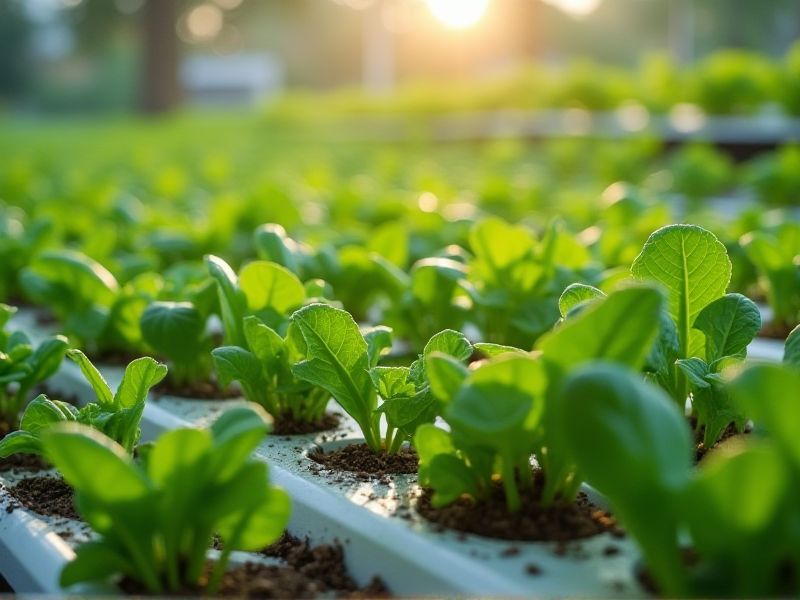
Hydroponic systems enable the efficient growth of plants without soil, utilizing nutrient-rich water solutions for optimal results. Popular hydroponic plants include lettuce, herbs like basil and mint, and strawberries, all thriving in these environments due to their shallow root systems. The absence of soil minimizes pest issues, allowing you to focus on plant health and yield. With precise control over pH and nutrient levels, hydroponics can significantly reduce growth cycles compared to traditional gardening methods. Furthermore, this technique conserves water, making it an eco-friendly choice for urban gardening enthusiasts.
List of some Hydroponic plants that grow with ease
- Lettuce (Lactuca sativa)
- Spinach (Spinacia oleracea)
- Basil (Ocimum basilicum)
- Mint (Mentha)
- Kale (Brassica oleracea)
- Arugula (Eruca sativa)
- Chives (Allium schoenoprasum)
- Cilantro (Coriandrum sativum)
- Swiss Chard (Beta vulgaris)
- Watercress (Nasturtium officinale)
Important things about Hydroponic plants that grow with ease
Nutrient Solutions
Hydroponic plants thrive on nutrient solutions that provide essential minerals directly to their roots, promoting faster growth and higher yields. Key components of these solutions include nitrogen, phosphorus, potassium, calcium, magnesium, and trace elements, which are vital for the development of healthy plants. By using a balanced nutrient solution tailored to specific plant needs, you can ensure optimal absorption and minimize deficiencies. Popular hydroponic crops like lettuce, basil, and tomatoes flourish in nutrient-rich environments, making them ideal choices for beginners in hydroponics.
Ph Levels
Maintaining optimal pH levels between 5.5 and 6.5 is crucial for hydroponic plants, as this range ensures maximum nutrient availability. Lower pH values may lead to nutrient deficiencies, while higher levels could result in nutrient lockout, negatively impacting growth. Regular monitoring of pH using a reliable meter is essential for successful hydroponic cultivation; fluctuations can occur due to nutrient uptake and microbial activity. Understanding and adjusting the pH will greatly enhance the ease and efficiency of growing robust, healthy hydroponic plants.
Light Requirements
Hydroponic plants thrive in controlled environments where light is crucial for their growth and development. Many varieties such as lettuce, basil, and spinach prefer bright, indirect light, making them ideal for hydroponic setups. Using LED grow lights can optimize photosynthesis while reducing energy costs, as these lights can be tailored to specific wavelengths that plants need. Monitoring light duration is equally important; most hydroponic plants benefit from 12 to 16 hours of light daily to ensure robust growth and high yields.
Water Quality
Hydroponic systems thrive on optimal water quality, which includes a balanced pH level typically around 5.5 to 6.5 for nutrient uptake. Maintaining a consistent temperature between 65degF to 75degF ensures that the dissolved oxygen levels in the water remain high, promoting healthy root growth. The use of nutrient-rich solutions tailored for hydroponics provides essential minerals and vitamins to your plants, enhancing growth and yield. Regularly monitoring and adjusting the Electrical Conductivity (EC) helps maintain the right concentration of nutrients, guaranteeing your hydroponic plants grow with ease.
Oxygenation
Proper oxygenation is vital for hydroponic plants, as it promotes healthy root growth and optimal nutrient absorption. In a hydroponic system, roots are submerged in a nutrient-rich water solution, making it essential to maintain adequate oxygen levels to prevent root rot and encourage aerobic respiration. You can enhance oxygenation by incorporating air pumps and diffusers, which introduce bubbles into the nutrient solution, ensuring that your plants receive the oxygen they need. Choosing the right medium, such as expanding clay pellets or perlite, can also support better air circulation around the roots in a hydroponic setup.
Temperature Control
Maintaining the optimal temperature for hydroponic plants is crucial for their growth and yield. The ideal temperature range typically falls between 65degF to 75degF (18degC to 24degC), allowing plants to photosynthesize efficiently while reducing the risk of stress-related diseases. To ensure precise temperature management, consider using thermostats and environmental control systems, which can automatically adjust heating or cooling as needed. By carefully monitoring and regulating these temperature variables, you can create an ideal growing environment that promotes healthy plant development and maximizes your hydroponic garden's output.
Growth Medium
For hydroponic plants, an ideal growth medium enhances nutrient absorption while providing stability and moisture retention. Coco coir, a popular choice, is derived from coconut husks and offers excellent aeration and drainage properties. Rock wool, another effective medium, allows for efficient water retention and promotes healthy root development. When selecting your growth medium, consider options that reduce the risk of overwatering and support optimal pH levels for thriving hydroponic plants.
Air Circulation
Air circulation is crucial for the health and growth of hydroponic plants, ensuring that they receive adequate carbon dioxide for photosynthesis while helping to regulate temperature and humidity levels. Proper airflow prevents the buildup of excess moisture, reducing the risk of mold and fungal diseases that can jeopardize your crop's vitality. Utilizing fans or air pumps can create a more uniform environment, encouraging robust root development and optimizing nutrient absorption. By maintaining a well-ventilated hydroponic system, you can support higher yields and healthier plants throughout their growth cycle.
Plant Selection
When choosing hydroponic plants, consider fast-growing varieties like lettuce, basil, and spinach, as they thrive in nutrient-rich water environments and have short growth cycles. These leafy greens require minimal space and can flourish in systems such as nutrient film technique (NFT) or deep water culture (DWC). Growing herbs like cilantro and mint can also be rewarding, as they add flavor to your dishes while flourishing in hydroponic systems. You can enhance your gardening experience by incorporating fully automated setups, which simplify nutrient management and ensure optimal growth conditions.
System Maintenance
Hydroponic systems require regular maintenance to ensure optimal growth conditions for your plants. This includes monitoring nutrient levels, adjusting pH, and regularly cleaning tanks and equipment to prevent algae buildup. You should also check for any signs of pests or diseases, which can be more easily managed in a controlled environment. Proper maintenance not only promotes healthy plant growth but also maximizes your overall yield and efficiency in hydroponic setups.
